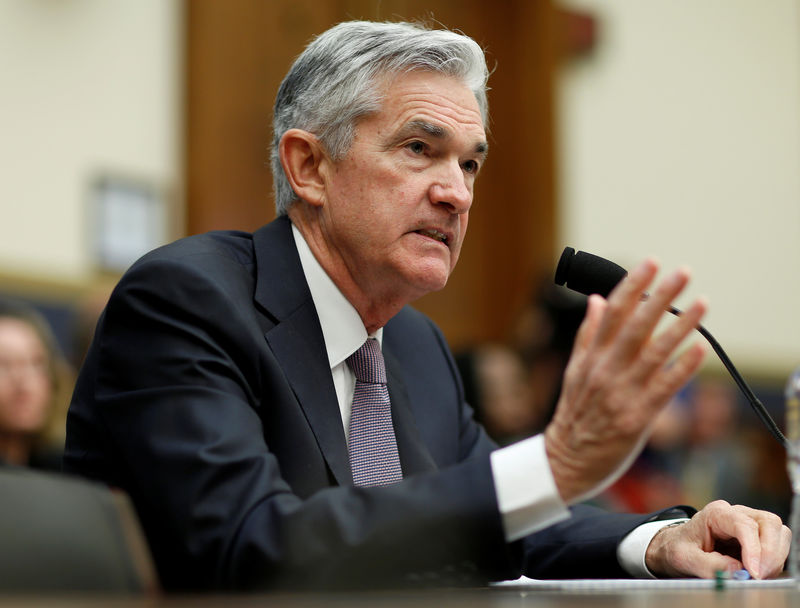 © Reuters. Federal Reserve Chairman Jerome Powell delivers the semi-annual Monetary Policy Report to the House Financial Services Committee hearing in Washington
© Reuters. Federal Reserve Chairman Jerome Powell delivers the semi-annual Monetary Policy Report to the House Financial Services Committee hearing in WashingtonBy Howard Schneider and Lindsay Dunsmuir
WASHINGTON (Reuters) – Financial markets barely batted an eye on Tuesday when Jerome Powell’s first public statement as Federal Reserve chief saw daylight, interpreting it as a steady-handed commitment to the U.S. central bank’s policy of gradual interest rate increases.
The calm evaporated about a couple of hours later, at 10:42 a.m. EST (1542 GMT), when Powell, testifying before a U.S. House of Representatives committee, struck a bullish, and personal, tone on the strength of the economy.
U.S. bond yields jumped as investors increased their bets for four rate increases this year, rather than the three that Fed policymakers projected in late December, and began asking one key question:
Is a hawk or a dove now running the Fed?
“The message coming from the written portion of the testimony did not signal any change,” analysts from Barclays (LON:) wrote on Tuesday, drawing a contrast with Powell’s live remarks that “point to a risk of a steeper policy rate path.”
Fed policymakers consider their public statements an important tool in shaping public perceptions and, in doing so, making monetary policy more effective.
They try to avoid off-the-cuff remarks that cause impromptu repricing, preferring to hew close to their job of representing the views of the Fed’s rate-setting committee and avoiding disclosing much about their personal opinions.
Veteran Fed analysts were split over whether Powell had broken that unwritten rule in his remarks, which came just weeks after he took over from Janet Yellen.
“The tone of the testimony was definitely NOT hawkish,” said Cornerstone Macro economist and former Fed staffer Roberto Perli, who emphasized Powell’s written comments might be read as a willingness to allow the economy to run hot in order to boost inflation to the Fed’s 2 percent target on a sustained basis.
“Powell more confident on growth, putting 2018 dots in play,” is how JP Morgan’s Michael Feroli summed up the day, referring to the quarterly “dot plot” of projected interest rates that Fed policymakers submit.
Feroli argued that Powell’s “modestly hawkish” appearance in Congress strengthened the chance that policymakers’ rate outlook would rise when the central bank issues its next set of economic projections next month.
(Graphic: Stock market sours as Powell talks up economy – http://reut.rs/2FcyOuI)
(Graphic: Fed chiefs’ congressional debuts and market reactions – http://reut.rs/2BSSiT4)
MARKET MOVES
Traders in short-term interest rate futures were shading to the hawkish interpretation on Wednesday, betting squarely on rises in borrowing costs at the Fed’s policy meetings in March, June, and September, and putting a high likelihood of a fourth increase sometime in 2018.
Before Powell’s testimony, they had seen the Fed as likely to wait until December before raising rates a third time, if indeed it chose to do so at all.
The market moves, however, were hardly dramatic or unprecedented.
Former Fed chief Ben Bernanke famously set off a global bond rout – the “taper tantrum” – in 2013 when he indicated the central bank was about to scale down the bond buying program it began to fight the 2007-2009 financial crisis.
In 2014, at her first press conference as Fed chief, Yellen jostled markets when she said the central bank could raise interest rates around six months after ending its bond-buying program. The Fed’s first post-crisis rate increase came in December 2015, more than a year after it ended the bond-buying.
Powell’s comments on his personal outlook “was basically like him saying, ‘my dot is going up,'” said Tim Duy, an economics professor at the University of Oregon, in contrast to Bernanke and Yellen who felt they should never reveal their own “dots.”
The current Fed chief will have a chance to clarify his views when he goes before a Senate panel on Thursday. Powell may try to stick closer to the script set out in his testimony in which he pledged to gradually raise rates while preventing the economy from overheating.
Source: Investing.com




























